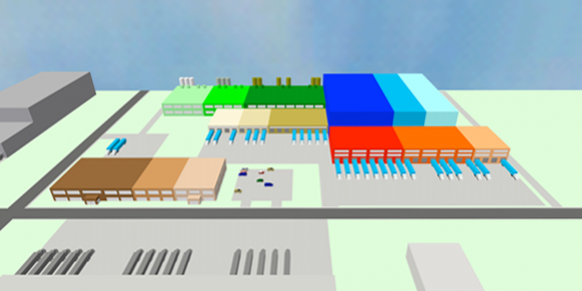The expansion of warehouse buildings and logistics centres poses major challenges for the plant development of many companies:
- The demand for space in logistics is increasing, especially due to e-commerce.
- Grown and fragmented plant structures make it difficult to expand existing locations.
- In many municipalities, commercial space is currently in short supply.
- Automated logistics systems are increasingly being used, the expansion of which is much more demanding than manual processing.
This makes it all the more important for companies to make optimal use of their land and to have long-term expansion concepts.
What is a master plan?
A master plan, also called a plant structure plan, is a concept for the long-term development of a company location. It determines how the buildings and functions of a plant are to be arranged on the site, how they are to be enlarged and what capacities will result. At the same time, the master plan includes a material flow that is coordinated with the overall structure and pre-planned up to the maximum expansion.
The most important objectives when designing a master plan are:
- Maximum expansion possibilities of all relevant functions on one property as required and without the need for conversion or deconstruction.
- Realisation of the expansion without significant interference with ongoing operations
- Coherent material flow for the entire plant at all times, with internal transport routes that are as short and directed as possible
Such a plan for the development of the plant structure must include expansion possibilities for all operational functional areas (administration, production, logistics, etc.).
The complete structural development of the factory site is divided into expansion stages. The construction stages and their individual building blocks, such as building types and storage systems, are designed modularly. In this way, it is possible to select and realise the appropriate module type according to requirements.
When does it make sense to develop a master plan?
Both for greenfield planning and for the optimisation of existing plants, the development of a long-term plant structure plan is advantageous. Especially when already
- grown and fragmented structures exist,
- internal transport causes disproportionately high costs, or
- the expansion of the site is problematic due to the existing building structure,
the creation of a master plan is usually necessary in order to optimally exploit the remaining potential of the site.
A plant structure plan offers the greatest benefit if it is drawn up before the first construction stage. On the one hand, buildings and traffic routes can then be optimally arranged. On the other hand, it is possible to plan later expansions in advance, both structurally and technically. This procedure saves investments compared to retrofitting at a later date.
How do you develop a master plan?
The development of a master plan can be roughly divided into three steps:
- The development potential and the requirements for the property are analysed. This includes the determination of weak points, the design of development scenarios, the identification of unchangeable framework conditions (fixed structural points, legal framework conditions, etc.), the identification of expansion areas and other aspects.
- Based on the analysis, various expansion scenarios are developed for maximum development of the site. These are made up of modules that can be realised independently of each other.
- The concept is divided into sensible expansion steps for the maximum development of the factory site. In this way, a master plan with a step-by-step concept is created that can be realised according to the company‘s needs.
What are the most common mistakes when creating a master plan?
Most mistakes in master planning are made in the following areas:
- Project management: Master plans that do not sufficiently involve all functional areas often fail due to lack of feasibility and acceptance.
- Modular conception: Hardly any company can predict its development in the next 10 to 20 years. If the planning modules (buildings, functional areas, workplaces, etc.) are not designed in a modular way so that they can be expanded, changed and exchanged, a master plan is inflexible and almost worthless.
- Holistic planning: If the focus of a plant structure planning is solely on the development of the buildings, processes and material flow suffer. As a result, expensive bridge constructions or other makeshift solutions are often created, which significantly worsen the handling.


